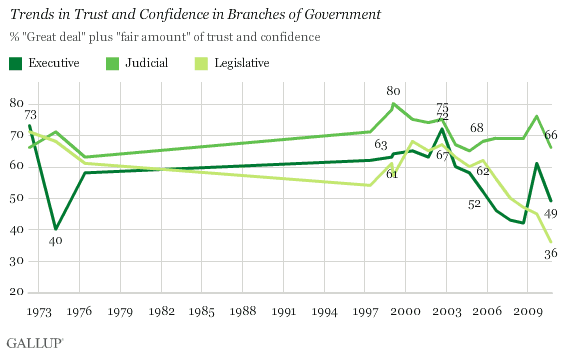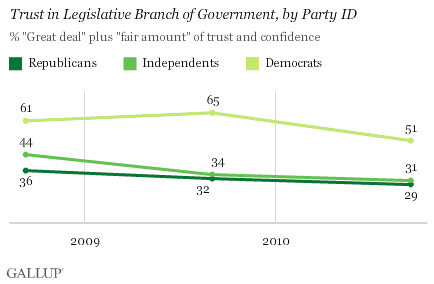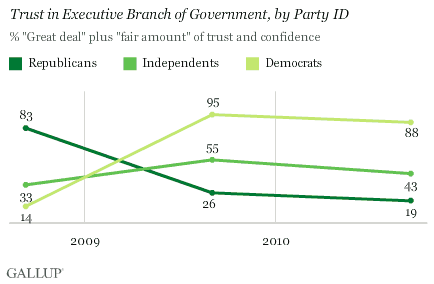PRINCETON, NJ -- A record-low 36% of Americans have a great deal or fair amount of trust and confidence in the legislative branch of government, down sharply from the prior record low of 45% set last year. Trust in the judicial branch and trust in the executive branch also suffered sharp declines this year but remain higher than trust in the legislative branch.

Gallup has measured these trends each year since 2001 as part of its annual Governance survey, and prior to that on an occasional basis in the 1990s and the 1970s. While trust in the legislative branch has been steadily declining for years, trust in the other two branches of government -- the executive and the judicial -- had risen in 2009 compared with 2008. All in all, between last year and this, trust in the legislative branch fell 9 percentage points, trust in the executive branch fell 11 points, and in the judicial branch, 10 points.
Trust in the legislative branch was highest, at 71%, in May 1972, and remained generally high from that point to the mid-2000s. It then dropped to 50% in 2007, 47% in 2008, and 45% in 2009, all record lows at the time they were measured. This year's 36% legislative confidence rating marks still another record low, and is the lowest trust level in any of the three branches of government in Gallup's history.
Trust in the executive branch has shifted up and down with some frequency over the last four decades, generally in sync with movement in presidential job approval ratings. Gallup measured the lowest level of trust in the executive branch, 40%, in April 1974, in the midst of the Watergate scandal, which later that year resulted in Richard Nixon's resignation. Trust was nearly as low in the waning years of the George W. Bush administration. Last year, the first year of the Barack Obama administration, trust in the executive branch shot up to 61%, but it has fallen back again this year, coinciding with the fall in Obama's job approval ratings to below 50%.
Trust in the judicial branch of government is at 66%, down from last year but roughly in line with readings since 2003. Gallup recorded the highest judicial branch trust reading, 80%, in February 1999, at about the time the Supreme Court's Chief Justice William Rehnquist was presiding in the U.S. Senate over the impeachment trial of President Bill Clinton.
Trust in Legislative Branch Remains Highest Among Democrats
Trends in trust in the legislative branch over the last three years have differed among partisan groups. Democrats have evinced the most trust in all three years, but the 14-point drop for Democrats between 2009 and this year is much larger than the 3-point drops among independents and Republicans.

Shifts among partisan groups in ratings of the executive branch have been much more dramatic, reflecting the change from a Republican to a Democratic presidential administration between 2008 and 2009.

Democrats' trust in the executive branch jumped more than 80 points between 2008 and 2009, while Republicans' trust fell almost as sharply. This year, ratings of the executive branch have dropped at least marginally across all partisan groups, with the 12-point drop among independents being the largest.
Implications
The substantial drop in Americans' trust in the legislative branch of government reflects the same underlying attitudes that have resulted in low congressional job approval ratings and a number of other indicators underscoring the public's disenchantment with its elected representatives. These trends are particularly important this year, given the midterm elections, which will almost certainly affect the composition and perhaps party control of both the House and Senate. The overall record-low levels of trust in the legislative branch undergird the expectation that voters this fall may be attempting to express their frustrations with Congress by voting out incumbents and/or members of the incumbent party.
Results for this Gallup poll are based on telephone interviews conducted Sept. 13-16, 2010, with a random sample of 1,019 adults, aged 18 and older, living in the continental U.S., selected using random-digit-dial sampling.
For results based on the total sample of national adults, one can say with 95% confidence that the maximum margin of sampling error is ±4 percentage points.
Interviews are conducted with respondents on landline telephones (for respondents with a landline telephone) and cellular phones (for respondents who are cell phone-only). Each sample includes a minimum quota of 150 cell phone-only respondents and 850 landline respondents, with additional minimum quotas among landline respondents for gender within region. Landline respondents are chosen at random within each household on the basis of which member had the most recent birthday.
Samples are weighted by gender, age, race, education, region, and phone lines. Demographic weighting targets are based on the March 2009 Current Population Survey figures for the aged 18 and older non-institutionalized population living in continental U.S. telephone households. All reported margins of sampling error include the computed design effects for weighting and sample design.
In addition to sampling error, question wording and practical difficulties in conducting surveys can introduce error or bias into the findings of public opinion polls.
View methodology, full question results, and trend data.
For more details on Gallup's polling methodology, visit www.gallup.com.
